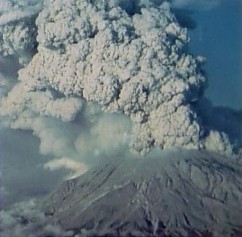
THE AIRLINE PILOTS FORUM & RESOURCE
Volcanic Clouds |
| Source: Excerpt from The Book " Weather " |
 |

During prehistoric times, volcanic activity was far more frequent and violent than it is now, and the gases belched into the sky from volcanoes --- including carbon dioxide and oxygen --- contributed to the formation of our atmosphere. Volcanic clouds had a significant effect on the climate, reducing temperatures and intensifying precipitation. Nowadays, major eruptions occur only from time to time, but the power of these eruptions is so immense that they still have a short-term influence on the weather, and their effects are seen worldwide. Volcanic eruptions eject huge amounts of ash and dust particles into the atmosphere and these are dispersed around the globe. In a powerful eruption, some of this material may pass through the tropopause into the stratosphere. Stratospheric winds may then keep the ash and dust circulating around the Earth for several years. Large ash clouds have a significant effect on weather patterns because they reflect a certain amount of incoming solar radiation back into space, inhibiting the heating effect of the Sun. This was first noticed by Benjamin Franklin after a volcanic eruption in Iceland in 1783, when he discovered that sunlight directed through a magnifying glass would no longer set fire to a piece of paper. In Europe, the year after the greatest eruption on record, on the island of Tambora near Borneo in 1815, became known as the "year without a summer". Similarly, the eruption of Mount Pinatubo in the Philippines in 1991 created a sulfuric acid haze in the stratosphere that later spread around the globe. This probably had a cooling effect on world climate that may have lasted for more than two years. However, while temporary cooling almost certainly occurs because of volcanic eruptions, it is difficult to separate this effect from the fluctuations in temperature that occur as part of our normal weather patterns. Nor is it clear whether any other variables, such as rainfall, are affected.
VOLCANIC TWILIGHTS
Volcanic dust has a significant effect on our blue skies and red sunsets. When sunlight passes through our atmosphere, particles in the air scatter the colors of the spectrum. The colors we see change according to the angle at which the light passes through the atmosphere, which varies with the time of day. The addition of volcanic dust to the atmosphere increases the number of particles and hence the scattering of colors. This means that colors at the red end of the spectrum are more effectively dispersed across the sky, producing paler daytime skies and intense red and purple sunsets (known as volcanic twilights) and sunrises. Volcanic eruptions can be a major hazard to aviation, because the small particles thrust into the atmosphere may clog airplane engines. Several recent near-disasters led to the founding of an international aviation warning system, run by the World Meteorological Organization (WMO). Satellite images of volcanic clouds are studied together with forecast dispersal patterns, so that no-go areas for aircraft can be established. |
Acknowledgement: John W. Zillman, William J. Burroughs,
Bob Crowder, Ted Robertson, Eleanor Vallier-Talbot and Richard Whitaker.


